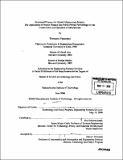Structure finance for hybrid infrastructure models : the application of project finance into public-private partnerships for the construction and operation of infrastructure
Author(s)
Patramanis, Theodoros
DownloadFull printable version (5.041Mb)
Other Contributors
Massachusetts Institute of Technology. Technology and Policy Program.
Advisor
Fred Moavenzadeh.
Terms of use
Metadata
Show full item recordAbstract
This thesis studies the application of project finance as the most efficient financing method for the construction and operation of infrastructure projects such as motorways, airports, power plants, pipelines, wastewater/sewage plants, dams, landline or cellular networks, and natural resources mines. These are large-scale, complex, and capital-intensive engineering systems, which until recently, were developed and operated either by the public or the private sector. The latest model for the construction and operation of an infrastructure project is Public-Private Partnerships ("PPP"), a hybrid structure that is becoming widespread. PPP employ private companies to construct and then operate infrastructure assets, which historically have been financed with public resources and operated on a not-for-profit basis. Through PPP agreements such as concessions, governments shift construction and operating risks to the private sector, which is usually more efficient in building and then running the assets. Project finance is a large and rapidly growing subfield of finance, yet one where academic theory and research distantly lag current practice. Project finance relies on private capital sources for financing the PPP infrastructure project, as opposed to direct government financing or corporate financing. (cont.) The thesis hypothesis is that project finance constitutes the most robust and sophisticated financial mechanism for maximizing return on investment and mitigating risk in PPP infrastructure projects. It is the goal of this thesis to provide the organizational methodology, financial application, risk management techniques, and explain all relevant aspects of project finance so that public policy makers, developers, bankers, contractors, and other decision makers will be in a position to holistically evaluate this financial instrument and accordingly proceed to its adoption for financing infrastructure projects.
Description
Thesis (S.M.)--Massachusetts Institute of Technology, Engineering Systems Division, Technology and Policy Program, 2006. Includes bibliographical references (p. 103-106).
Date issued
2006Department
Massachusetts Institute of Technology. Engineering Systems Division; Technology and Policy ProgramPublisher
Massachusetts Institute of Technology
Keywords
Technology and Policy Program.